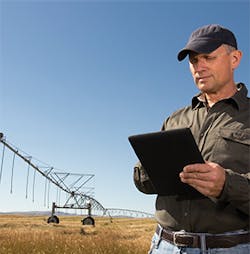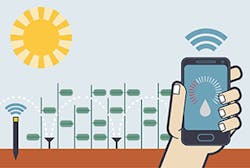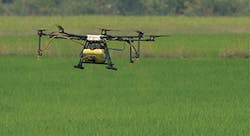On ag land across the nation, Wi-Fi streams as steadily as water from sprinklers, powering the devices that keep track of each drop of water that hits farmers’ crops.
The latest innovations in irrigation technology range from smart sensors and drones for moisture monitoring to better data analytics software. This high-tech world of options has been slowly adopted among farmers for the past few years as the agriculture industry looks to expand its water savings and cut down on expensive water bills.
“We’re just entering into an era that’s going to be pretty exciting,” says Stephen Smith, water resources and irrigation engineer for his consulting service Wade Water LLC, which advises farms on water resource planning and SCADA system design, based in Fort Collins, CO. “It has to do with IoT, big data, and new sensors that are likely lower cost than ever before and lower power consuming.”
Smith says data collection was once done weekly or monthly in order to make decisions and meet necessary reporting requirements. But today’s technology makes it possible to check on crops in real time.
Irrigation technology has seen significant leaps in capabilities while the price steadily ticks down as more consumers buy smart irrigation products. As the demand for these products increases, the price has decreased due to increased competition, spurring more entrepreneurs to create new businesses. This growth has also created more innovation in the sector as manufacturers create new types of sensors—sensors that measure metrics with more detail, sensors that analyze data in easier-to-understand ways, sensors that automatically tell a pump to distribute water, and other innovations.
The Internet of Things is an umbrella term for any device that is internet-connected that isn’t a console or smartphone—think of the programmable lightbulbs or the Amazon Echo or Google Home device you might speak to regularly; those are IoT devices. However, instead of farmers using their phones to turn off the lights in their homes, they’re using their phones and computers to turn on and off their crop watering systems for optimized efficiency.
IoT watering systems take many forms, including above-ground sprinklers and subterranean drip irrigation sensors. Soil moisture sensors also act as superb monitoring systems, checking the salinity, the pH, and other metrics of the soil around the plant throughout the day. Some systems include soil monitoring inside smart sprinklers.
Some of these various technologies are simply different methods of collecting the same data, just from different angles of the field or terrestrially versus aerially. Some technologies are uniquely able to collect massive amounts of data that isn’t possible by other methods, including some measurements (like ultraviolet readings of the soil under crops) that are impossible to collect manually. In some cases, technology is a good supplement to getting out in the field to check on conditions by hand. In other cases, it can completely take a cumbersome job off a farmer’s hands by doing the work more efficiently and over a wider range.
There may be some situations where a technological tool will never replace a farmer’s intuition and historical knowledge—and while some functions like drip irrigation can be put on “auto pilot” based on the farmer’s needs, few sensors have been built with the artificial intelligence necessary to make decisions or take action without a farmer telling the machines what to do, when to do it, and by how much. But technology tools can lend a hand collecting invaluable hard data that an experienced farmer can use to make decisions.
Smith says the technology is reaching the point where soil moisture sensors are lower cost and contain batteries with much longer life spans, so they can be buried underground without a farmer having to worry about replacing dozens or hundreds of batteries every year.
“What that means to farmers is pretty significant,” he says.
Luke Wilson, senior product manager for Rain Bird Corporation, an irrigation product manufacturer based in Azusa, CA, says that while it’s not common to see farms that are entirely reliant on IoT sensors, they’re seen as a good supplement to traditional methods of visually inspecting crops and using analog measuring devices.
“How much water to apply is based on different factors depending on the grower, the crop, and the region,” he says. “Some growers rely on walking the fields each day, feeling the soil, studying the plant, and deciding how much water to put down.”
Wilson added that some farmers might be more inclined to use more sensors when these sensors and servers are cheaper and more powerful.
“Other growers squeezed by the cost of labor and having many acres under management use crop consultants and/or technology to monitor crops and soil conditions,” he says. “Many growers use a combination of sensors, consultants, and their own experience to develop a prescription for their blocks.”
Digital weather stations that can be installed onsite help farmers monitor current conditions such as ambient temperature, rainfall totals, humidity, soil tension, and other metrics that could help the farmer estimate and manage crop stress preventatively.
Wilson says irrigation technology can be categorized into two main areas of use: crop monitoring and operational monitoring.
“Crop monitoring is used to study crop stress to develop a prescription of water or nutrients to apply to ensure they only use exactly what the crop needs,” he says. “Operational monitoring and control are used to monitor and execute the retrieval, distribution, and application of water within an environment to ensure the prescription was applied as efficiently as possible. Farm labor, consultants, and increasingly technology are used for both types of monitoring and control.”
So what types of technology are available for farmers to purchase for their own farms? Many options. Depending on your needs and the size of your farm, you can look into specific systems that can cover all of your farm from one device or can place smaller systems across the width of a field. The types of sensors vary across a range of measurements, but here are a few that are on the market today:
- Sap flow sensors—Sap flow sensors track the amount and flow of nutrients through a tree and large stems over time. This can be accomplished with heat pulse velocity sap flow sensors, which are sensors with large needles that are pushed into a stem or branch to measure the downstream and upstream amounts of sap. Sap flow sensors can also (depending on the type purchased) measure transpiration and stem water content. Stems with smaller circumferences can be measured with clamp-like sensors that are fastened around an entire stem to determine the flow of nutrients in and out of the plant. Internet or intranet sensors can either send data individually back to the farmer, or they can be hooked up to a multi-sensor array that collects data from hundreds or thousands of plants and automatically arranges the data in one place. This type of data analysis helps farmers see what’s happening across their farm all at once, usually in an easy-to-understand chart or graph, rather than having to pore over spreadsheets from hundreds of individual plants.
- Dendrometer—Dendrometers record the shrinking and swelling of trunks and fruit over time, as well as growth. Dendrometers are a class of instruments that measure various metrics related to trees, and this includes dendrometer bands. Traditionally, analog dendrometer bands are straps of metal with a metal spring that are fitted around a tree trunk. The band stretches as the tree grows, swells, or shrinks. Internet-connected dendrometer bands (or automatic but not IoT bands) can speed up this process by collecting data that would otherwise have to be collected by reading each individual dendrometer at regular intervals. A 2008 report by New Mexico State University scientists stated that automatic dendrometers produced a 35 to 40% time savings over manual dendrometers.
- Spectral analysis—Spectral analysis, also called infrared canopy mapping, is a type of monitoring tool largely used by drones to image a field using infrared wavebands to see how much water is currently on the crops. The image is typically shown as a map, which can show areas where crops are stressed due to too much or too little moisture in the soil. This can help with changing irrigation schedules, creating more drainage, stopping up drainage or increasing irrigation for areas that are too dry, and other adjustments based on the needs of the plants. Spectral analysis can also be used on a variety of other wavebands, depending on the specific metric needing to be measured. Multispectral imaging, in which several different types of wavebands are used, can be used in a variety of farming-relating data collection methods, such as pest identification, fertilizer monitoring, and monitoring livestock by tracking the heat signatures of the animals at night or in hard-to-see conditions like fog.
- Soil moisture trapping—Soil moisture trapping studies the water that is available to a plant at any given time. These on-the-ground sensors evaluate soil volumetric water content by evaluating the soil’s ability to transmit electricity, also called the dielectric constant of the soil, which is a larger number with a greater amount of water. This is possible essentially because water is a good conductor of electricity, whereas soil and rocks are not. These sensors are typically buried near the roots of plants and should be well packed inside the soil (but not too compressed; the right balance there is important) so no air bubbles mess up the readings. This data is sometimes then sent back to an overall soil moisture system that opens or closes an automatic irrigation channel based on the readings it gets from the sensors and based on preset guidelines put into the system by the farmer.
- Pressure chamber—Pressure chambers, also called pressure bombs, measure the amount of moisture available within a plant at any given time. Pressure chamber sensors study this amount and how it changes over time in order to help farmers understand the suction forces within a plant. This pressure chamber applies air pressure to a leaf and looks at the amount of pressure needed to cause water to appear on a petiole. This shows you the amount of tension inside the plant and can be used to evaluate plant health and plant stress.
Aerial data collection isn’t new. Farmers have hired small planes equipped with UV sensors and other sensors for years to collect data and bring it back down to Earth. But a drone can easily fly across hundreds of acres without the expense and risk of hiring a pilot, and the data can be transmitted back in real time as the drone flies across a farm. Drones can be flown manually by an operator to observe specific areas of concern, or they can be programmed with an automatic flight path so regular data sweeps can be done, even in the middle of the night.
Smith says drones have become more affordable over the past years, noting DJI drones (one of the most popular drones for users who are not using the drone as a toy, nor do they require the most expensive brands for high-altitude flying or high-definition video) are about $1,000 now, whereas they once cost thousands of dollars, and are relatively easy to learn to fly.
Drones are also used to scout new farmland, to monitor wildlife that is free-range, to spot sinkholes, and to identify levee breaches in the event of flash floods.
It should be noted that Federal Aviation Administration laws now require a Remote Pilot Certificate in order to fly for commercial use. That process is explained on the FAA’s website, and certain additional waivers are sometimes required. For example, if you wanted to fly your drone at night to keep track of a herd of livestock, that would require an extra waiver.
Smith says the ability to put an aircraft in the sky at any time has opened up many more possibilities for planning in terms of irrigation in order to stop a problem in its tracks before it becomes overwhelming.
“If you can fly the drone on a weekly basis and look for changes in coloration of the crop, that can help you go to a stop to check out some perceived problem,” he says.
Just like the price of home sensors have dropped precipitously in the past few years, so have sensors made for farms. Smith says the decline in price of IoT sensors for irrigation follows a trend across the industry of cheaper, more powerful devices that will hopefully make it easier to collect data.
Sensors are still not at a price point where they make sense for all farmers and all farms, Smith says, but the decline is noticeable year after year. Eventually, he says, he hopes they will get to a point where any farmer can pick up enough to cover their entire farm.
“If those sensors cost a fraction of what they used to cost, maybe [farmers] could afford 50,” says Smith.
Farmers have long been on the forefront of new methods, both technological and analog, that can make their crops more efficient and less expensive to produce. Water restrictions, especially in drought-stricken areas like California, imposed by state and regional governments in the past decade have made farmers in those areas particularly innovation-minded.
“In the last 10 years, we’ve seen severe changes in growers’ ability to access natural sources of water and the regulation and monitoring of these sources. In the last 10 years, the price, as well as the scarcity of labor, has dramatically increased the cost of running an operation,” he says of Rain Bird’s clients. Rain Bird is based in California, where a severe drought led the state to impose water use restrictions in the past few years. “We’ve seen these pressures lead to a more significant consolidation both at the grower, reseller, and manufacturer level to leverage scale. Also because of all of these environmental changes we’ve seen an increase in the interest and adoption of technology throughout farming operations. You have fewer people working more acres at a higher cost with increased regulations on water use.”
Smith says farmers want to make sure whatever method they use is as consistent and reliable as the methods they’ve been using already—some of which have been in use for a generation or more, and some methods are simply last year’s IoT sensor models.
Wilson says irrigation methods will continue to evolve and will require less and less of farmers’ valuable time as IoT sensors become more available, especially where regulatory data collection is concerned.
“Irrigation management will continue to shift from active to passive management and control,” he says, “allowing smaller workforces to cover more acres and provide critical data for stakeholders to make business decisions. Farmers face additional accountability for every drop, every chemical, every choice either from regulatory agencies, owners, or stakeholders. Technology will significantly reduce the burden, providing automatic reporting and control.”
Wilson says some sellers “promise their sensor or method is the one method to rule them all.” But that isn’t possible, Wilson says, because running a farm means needing a variety of irrigation metrics that can’t be collected on just one sensor array, and different crops will require different types of monitoring. He says some companies can over-promise that one sensor can do any job required, rather than working with clients to figure out the specific sensors that can meet that client’s individual needs.
“Growers commonly deploy multiple solutions in their operation to develop their own prescriptions since no one method is universal to all crops,” he says.
Smith adds that farmers don’t buy into the fallacy that “new” means “better,” and farmers are far from technological neophytes. Return on investment is the name of the game, and technology can be a powerful tool, but only if it actually works and if sellers can prove that their product will produce this tangible return on investment.
“We just don’t get too excited in the farming community about new technologies unless we can show it’s real and can be implemented cost-effectively,” he says. “No farmer…is going to spend a bunch of money if they can’t see how that’s going to impact their operation.”


